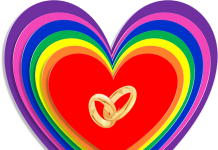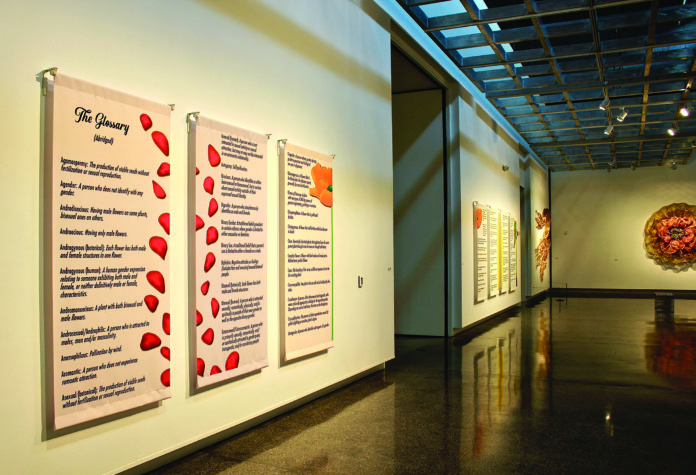In Denise Duarte’s exhibit “Unraveling Identities,” on display at The Studio inside Sahara West Library, there is a particular work of art in which human sexuality and identity is portrayed as a fl oral arrangement in a vase.
Its palette is brilliant. On the vase is a golden lyre. To the right of the work, made by the artist using ribbon on screen, hangs a key for the symbolism: Violets represent lesbians based on the Greek Poet Sappho of Lesbos, who is said to have draped her lovers in violets; the green carnations speak for Victorian gay men, who wore the flower to signify their identity; intersex is depicted by the rose and lily, each of which, fall into the classification of a complete or perfect flower when containing within itself “both the necessary male and female parts.” The list continues, including a Lord Byron fuchsia plant for bisexuality.
Titled “Flora Varieties” the work’s deep reverence and historical elements, placed near the entrance of the show serve as an exemplary lead-in, an overture to an exhibit in which plant diversity serves as convincing metaphor for human sexuality and gender.
The project began several years ago when Duarte, a lesbian, activist and artist in Las Vegas, started compiling two glossaries: One that lists botanical terminology. The other, human sexuality.
When she eventually merged the two, imbalanced as they were, it posed a question that was more than a passing rumination: What happened to the same human brain that created extensive terminology arranging the diversity of the plant world when it came to the human body?
For the latter, it stopped at two words, stamping humans as simply “binary.” And, history has proven over and over that damned be those who can’t find a place for themselves in box A or B.
Though the exhibit seems highly political in these charged times, Duarte doesn’t delve into politics. And, she intentionally offers no answers or historical explanations for traditional terminology.
Instead, she focuses on placing of words, fluidly interlacing terminology on nine panels. The analogy has already proven powerful. It was at her Master of Fine Arts thesis show at Maryland Institute College of Art (MICA) in 2013, when she fully realized she had something.
Visitors weren’t simply engaging in a piece or two, and then walking away. They were examining, discussing, considering and questioning as they read through the entire series of works on display.
Her glossary that was once less than four pages has since grown exponentially into a 19-page downloadable document into a 19-page downloadable document on her website. That there might be something more complex to humans, beyond male and female (and heterosexual, of course) seems to have willfully slipped the minds of those creating words, religions and laws in comparison to the virtuosity of the lively symphony that is botanical classification and this exhibit perfectly illustrates that.
“It’s like they sat down and reverted to this binary as a reality for humans,” Duarte says. “That puts limits on who people can be. When you’re told to be not what you are, that is traumatizing.”
Gender, she says, should be as that of the color of one’s eyes. Instead, in the 21st century it is still loaded with leftover Victorian belief systems. Homosexuality, she reminds in this show, is a word that wasn’t even created until the 19th century.
“A lot of the terminology on the wall didn’t exist,” she says, referring to the beginning of the research in 2012.
“We’ve had a tremendous growth in gender identity in the past six years. And what gender is and the many ways it manifests itself in human beings.”
On a recent Saturday afternoon at The Studio, families, individuals, couples and friends studied the exhibition, landing mostly on the nine panels of interlacing glossaries on the walls of what was once the home of the Las Vegas Art Museum.
They appeared fully engaged and lingered, whether they’d arrived at their intended destination or randomly wandered in while visiting the library. Call it an historical moment for either side in the fight for LGBTQIA+ equality. Duarte, a lesbian, and longtime activist, knows that fi ve or ten years ago this exhibit would be a different experience. But there has been a monumental cultural shift in recent years, perpetually expanding her work.
The artist says that while stopping in at the gallery one night she witnessed a father and his preteen daughter discussing their gender identities and adding their personally selected color-specific ribbons to “The Human Tapestry of Gender and Sexual Identity.” The tapestry invites visitors to select ribbons organized by color and identity that best describe them, then weave them into the already full loom bursting in colors, signifying the various gender and sexual identities (ranging from queer, intersex, straight or bi-curious to transgender, androgynous and cis) that have been woven in.
“It just shows the breadth of humanity and how beautiful we are really,” Duarte says.
Terminology is more than a way to communicate in society: “If it doesn’t have a classification, it doesn’t exist.”
The exclusion of the LGBTQIA+ identities within the context of terminology for humans lingers in the shadows of Duarte’s sculptural works of water and wind (pollinators). Each is made using screen, a material that people are accustomed to “looking through” as if it isn’t there, a “semipermeable barrier,” keeping nature out, she says. And from those shadows the LGBTQIA+ finally emerges.
Life may be vastly different and better now for LGBTQIA+ people, Duarte says. Pun intended, or not, she hopes unraveling identities helps plant another seed in society as it continues to change.
“To have a major shift in one’s perception is incremental,” she says. “My hope is that incremental will lead to acceptance.”
“Unraveling Identity,” art exhibit, through July 20 at Sahara West Library, 9600 W. Sahara Ave., Monday through Thursday, 10 a.m.-8 p.m., and Friday through Sunday, 10 a.m.-6 p.m. Walk and talk tours, July 11 at 6:30 p.m. and July 20 at 4 p.m., admission is free, 702-507-3630































